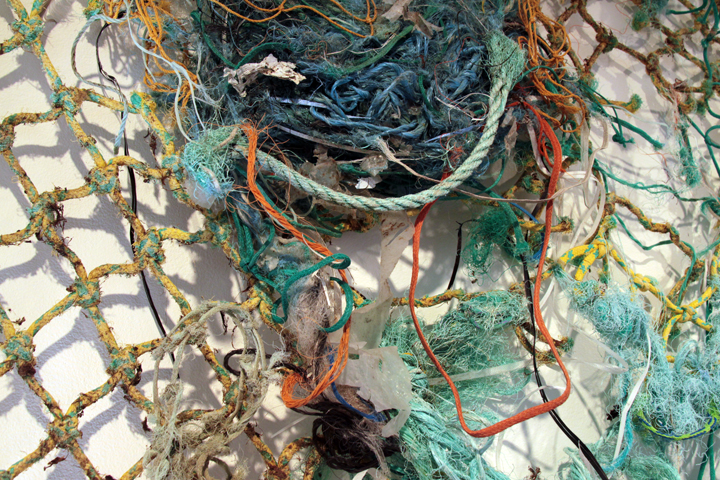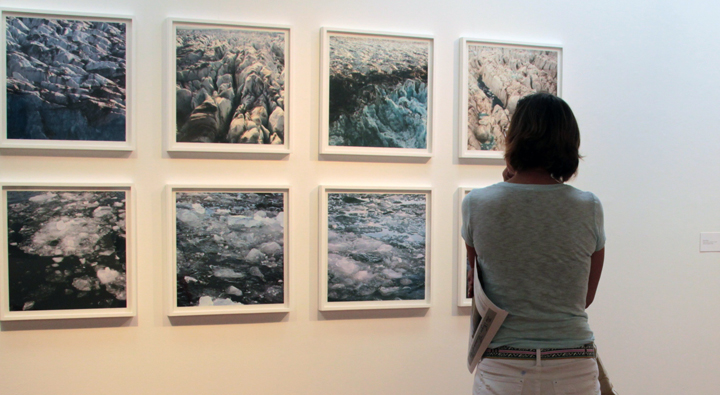Images from the Arctic on View at the Noyes Museum
The term “artist-in-residence” takes on an entirely new meaning when the residency happens aboard a specially outfitted, century-old sailing vessel in the High Arctic. The Arctic Circle expeditionary residency is a program that brings together international artists, as well as scientists, architects and educators, and offers these travelers unique opportunity for creation of new work through interdisciplinary collaboration and personal exploration.
On view now through January 10, 2016, Noyes Museum of Art in Oceanville, NJ, is “Frozen Earth: Images from the Arctic Circle,”an exhibition of work by eight international artists who participated in the 2013 Arctic Circle Expedition, a three-week trip to the international territory of Svalbard.
With paintings, audio and video, photography and sculpture, “Frozen Earth” shows the variety of ways that the artists – Diane Burko, Laura Petrovich Cheney, Deborah Hamon, Jane Isakson, Lauren Portada, Karen Power, Kate Puccia and Marianna Williams – use their particular artistic format to express the profound impression this unique experience had on their work and their lives.
After a recent visit to the Noyes Museum to see this exhibition, I talked to the Director of Exhibitions and Collections, Dorrie Papademetriou, about how “Frozen Earth” came to be.
“Laura Pertrovich Cheney, an artist who was on the 2013 exhibition, brought the Arctic Circle project to my attention,” Papademetriou told me.
“We both felt that doing an exhibition with artists who had been on the trip would be a way to raise awareness about climate change, which is an issue of worldwide significance.”
But, as she and I both agreed, the method by which a message is delivered can make a big difference.
“Frozen Earth”is a wonderful delivery system.
“In the show, you can see that each artist’s interpretation is different,” said Papademetriou. “The works capture the artist’s individual experience and what she or he wanted to communicate about that experience.”
When I went into the gallery, the first thing I noticed was a sonic undercurrent – something that sounded like ambient music. It was “Inside Arctic Ice,”a work by composer Karen Power created from recordings she made of moving glaciers and cracking ice during her three-week residency. It was a perfect backdrop for viewing the art. As the wall text explained, Powers intended for the piece to help the listener imagine what it was like to be on the ship in the Arctic. And it did just that, in a subtle but powerful way.
A series of photographs by Diane Burko caught my eye as I walked further into the gallery. Burko has been on expeditions to Antarctica and the Arctic Circle, and taken thousands of photographs from the air, sea and ground. The series in the exhibition is a stark and startling visual representation of the dire consequences resulting from rapid ice melt.
Jane Isakson’s paintings are big and bold, and beautifully blend the actual with the abstract. In her biographical material, Isakson says that the “search for symbols and meaning in nature lead her to the act of observation and painting.” That is evident in her art, which depicts the Arctic landscape with touches of magic and mystery.
A primary objective of Deborah Hamon’s photographs was to involve children and the community in an ongoing conversation about climate change and preserving the environment. With her Polar Pom-Pom Project, Hamon took pom-poms, created from environmentally-friendly materials by more than 600 grade school children, and photographed them in the High Arctic landscape.
Laura Portada’s bright and colorful palette knife paintings suggest a broader dimension to Arctic landscape. While the scenery of the area is mostly monochromatic, the shapes and composition of Portada’s paintings convey the effects of light and shadows, and invite the viewer to see this somewhat austere environment in a fresh way.
“Nice to See You, Pyramiden,”a video with sound by Marianna Williams, chillingly documents the fate of Pyramiden, Russia, a coal-mining town that suffered economic collapse and other tragedies in the 1980s. The abandoned settlement still contains artifacts of the community’s life, and Williams’ film shows both what has remained and what is no longer there.
Kate Puccia’s series, called “Porthole Portraits,” is a grouping of photographs that shows the immense Arctic landscape in smaller scenes, some up close and highly detailed and others with a wider focus. Also on display by Puccia are works that replicate field data, with a nod to geological soil and cloud values.
“Net Worth,” Laura Petrovich-Cheney’s piece, is a construction made from objects she gathered while in the Arctic, and illustrates a distressing but realistic perspective on the region. Petrovich-Cheney had expected the Arctic to be a pristine, untouched place, but instead discovered a surprising amount of garbage there. She collected bags full of trash, brought them home and assembled them into her artwork. She hopes that this tangible presentation will drive home the message that it is the responsibility of each one of us to tend and preserve the natural beauty of the earth.
In conjunction with “Frozen Earth,” the Noyes Museum will host a panel discussion on Thursday, September 10, from 6:30 – 7:30 p.m. Artist Laura Petrovich-Cheney organized the event, and photographer Diane Burko will serve as the moderator.
The panelists include: Michael Lemonick, a journalist who has written about science and the environment for TIME Magazine, as well as Discover, Scientific American, Wired, New Scientist, The Washington Post and National Geographic; Dr. Jeff Niemitz, Professor of Earth Sciences at Dickenson College, a former president of the National Association of Geoscience Teachers and a Fellow of the Geological Society of America; Andrew Revkin, who has covered science and the environment for more than 30 years in newspapers, magazines, books, documentaries and his New York Times blog Dot Earth;
Amy Lipton, a New York gallerist and co-founder of Eco Art Space; and Aaron O’Connor, the founding director of The Arctic Circle expeditionary residency program.
Papademetriou and the artists are very excited about the panel discussion, and the ways in which it will complement the exhibition.
“With our exhibitions, we try to present art that causes people to reflect and maybe even make changes,” said Papademetriou.
“Art can inspire action,” she said, “and that is something we hope to achieve with the exhibition and the panel discussion.”
And that was another reason to do this exhibition, Papademetriou told me. “We wanted to bring art and science together.”



